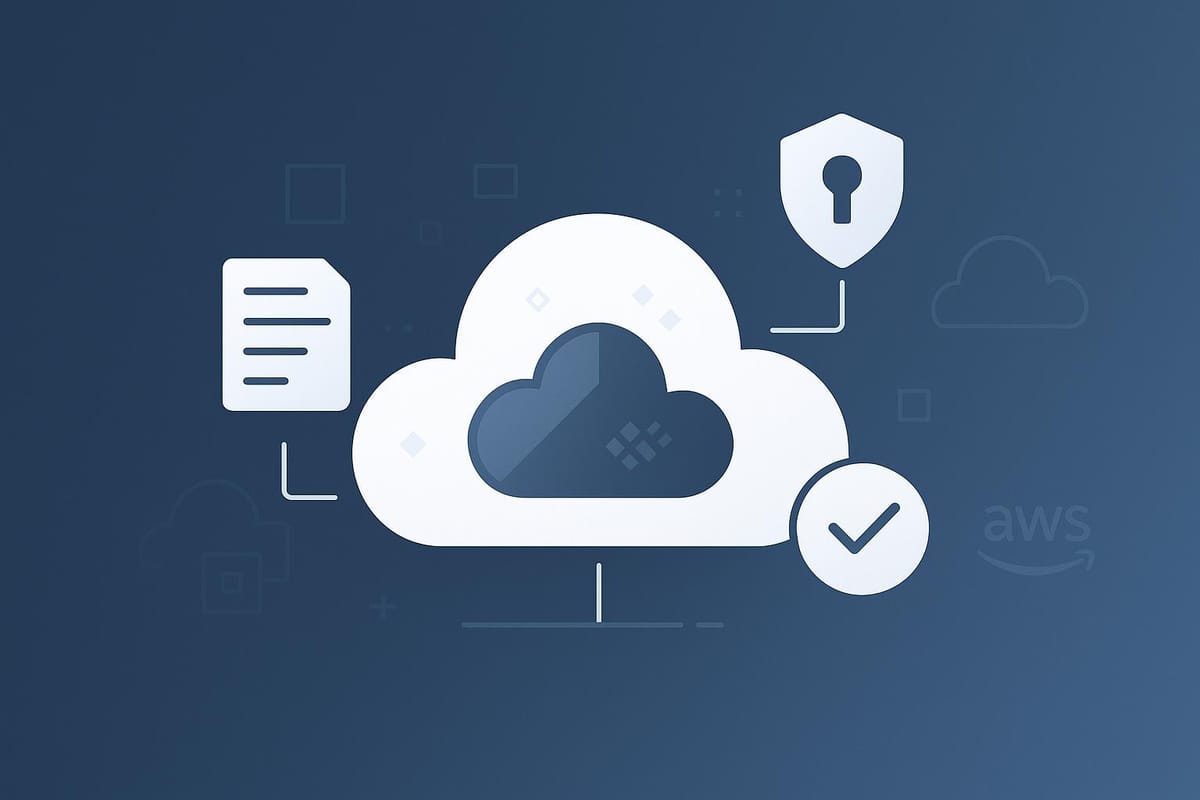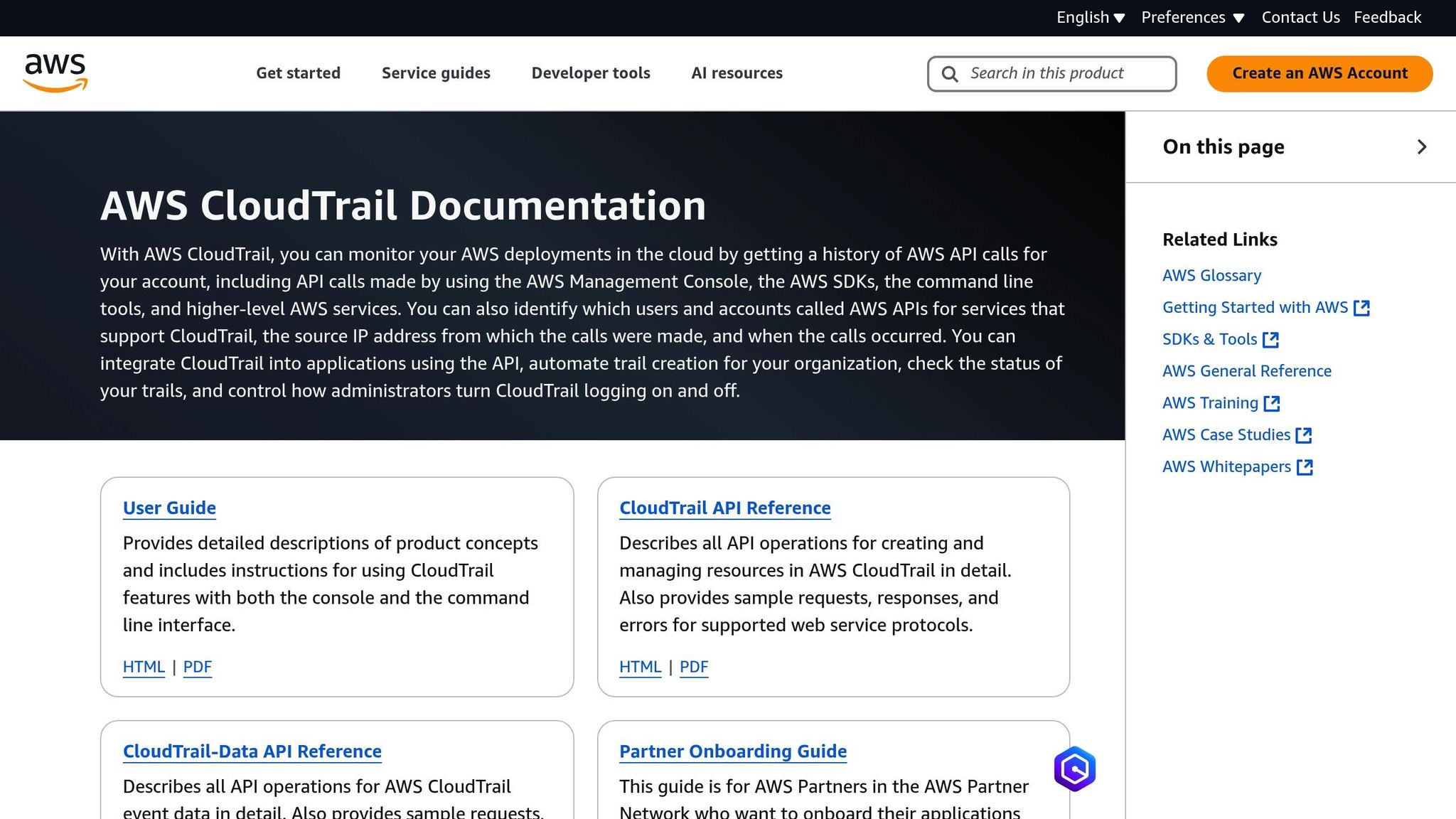AWS CloudTrail Setup for User Activity Logs
Learn how to set up AWS CloudTrail for effective user activity logging, compliance with UK regulations, and enhanced security.

AWS CloudTrail helps UK businesses track user actions, meet compliance requirements like GDPR, and enhance security. It logs API activities, identifies unusual behaviour, and supports long-term data storage. Here’s what you need to know:
-
Why Use CloudTrail?
- Tracks API calls and user actions for operational visibility.
- Detects security risks like unauthorised access.
- Meets compliance standards (GDPR, DPA 2018, FCA).
-
Key Features
- Logs user identities, IP addresses, and resource actions.
- Integrates with CloudWatch for real-time monitoring.
- Stores logs for 90 days by default, extendable via S3.
-
Setup Essentials
- Enable multi-region trails and log file validation.
- Use S3 with encryption and access logging.
- Configure alerts for critical events like root logins or policy changes.
-
UK Compliance Tips
- Keep logs for at least 12 months.
- Encrypt data using KMS.
- Restrict data to UK regions (e.g., eu-west-2).
CloudTrail ensures security and compliance while helping manage costs through selective logging and lifecycle policies.
AWS CloudTrail Basics

Core Functions
AWS CloudTrail keeps a record of all API calls made across your AWS setup. This includes activities via the Management Console, SDKs, command-line tools, and other services. It provides logs for:
- User and resource activity: Tracks access details not covered earlier.
- API call history: Logs all API interactions, whether successful or not.
- Resource changes: Records updates to AWS resources and configurations.
- Security events: Captures security-related actions and potential risks.
These logs form the foundation for the operational and security benefits discussed below.
Business Impact
CloudTrail offers several advantages for UK small and medium-sized businesses:
| Business Benefit | Implementation Impact |
|---|---|
| Operational Visibility | Tracks resource usage and user actions in real time. |
| Security Monitoring | Detects unauthorised access and unusual activities quickly. |
| Cost Management | Helps adjust resources to improve cost efficiency. |
| Incident Investigation | Speeds up finding the cause of security or operational issues. |
CloudTrail works well with other AWS tools. For instance, you can set it up to send logs to Amazon CloudWatch. This allows for real-time monitoring and automates responses to specific events.
Next, we’ll explore how CloudTrail supports compliance with important UK regulations.
UK Compliance Requirements
GDPR Compliance
CloudTrail helps organisations meet GDPR Article 30 requirements by keeping records of processing activities, such as:
- When access occurred.
- Actions taken on the data.
- The location of the access.
Financial Services Regulations
For UK financial institutions, CloudTrail ensures compliance with Financial Conduct Authority rules by maintaining detailed audit trails of system access and changes.
Data Protection Act 2018
The service supports compliance with the DPA 2018 by:
- Keeping logs of activity.
- Providing evidence for security measures.
- Aiding data protection assessments.
- Helping respond quickly to subject access requests.
CloudTrail Setup Guide
Initial Setup Steps
To set up CloudTrail in the AWS Management Console, follow these steps:
- Access CloudTrail Console: Open the AWS Management Console and select CloudTrail from the services menu.
-
Create a Trail: Click on "Create trail" and fill in the following details:
- Trail name: For example, "prod-audit-trail".
- Storage location: Choose an S3 bucket (create a new one or use an existing bucket).
- Log file prefix: Specify a prefix for your log files.
-
Configure Trail Settings: Adjust the following options:
- Enable for all regions (recommended to meet UK compliance standards).
- Include global services.
- Turn on log file validation.
- Use SSE-KMS encryption for added protection of sensitive data.
Log Settings
Properly configure your CloudTrail logs to ensure secure and compliant storage.
S3 Bucket Configuration
Set up your S3 bucket with these recommended settings:
| Setting | Recommended Value | Purpose |
|---|---|---|
| Retention Period | 365 days | Aligns with UK regulatory standards. |
| Versioning | Enabled | Protects against unauthorised modifications. |
| Encryption | SSE-KMS | Safeguards data with encryption. |
| Access Logging | Enabled | Monitors access attempts to the bucket. |
Permission Settings
Apply bucket policies to restrict access. Use the following example policy to allow CloudTrail to access your bucket:
{
"Version": "2012-10-17",
"Statement": [
{
"Sid": "AWSCloudTrailAclCheck",
"Effect": "Allow",
"Principal": {
"Service": "cloudtrail.amazonaws.com"
},
"Action": "s3:GetBucketAcl",
"Resource": "arn:aws:s3:::your-bucket-name"
}
]
}
Once storage is secured, you can move on to setting up real-time monitoring using CloudWatch.
Monitoring Configuration
To enhance visibility and receive alerts for critical events, integrate CloudTrail with CloudWatch.
1. Set Up a CloudWatch Log Group
Create a log group and set its retention period to 12 months to comply with UK regulations.
2. Create Metric Filters
Define metric filters to track key events. Below are some examples:
| Event Type | Filter Pattern | Alert Threshold |
|---|---|---|
| Root Login | {$.userIdentity.type = Root} |
Every occurrence |
| IAM Changes | {$.eventName = Create* OR $.eventName = Delete*} |
Within 5 minutes |
| Security Group Changes | {$.eventName = *SecurityGroup*} |
Within 15 minutes |
3. Configure Alerts
Set up CloudWatch alarms and link them to SNS notifications for timely updates:
- Critical alerts: Immediate notifications.
- Warning alerts: Notifications within 30 minutes.
- Information alerts: Daily summaries.
This configuration ensures you stay informed about important events and maintain compliance.
CloudTrail Implementation Tips
Log Security Measures
To keep your CloudTrail logs secure, use AWS KMS with customer-managed keys and enforce strict IAM controls. Here's what to focus on:
- Automatic key rotation every 365 days to maintain security.
- Monitoring KMS usage with CloudWatch and applying least-privilege IAM roles.
- Log file integrity validation to ensure logs remain unaltered.
Update your bucket policy to include these security features:
| Security Control | Configuration | Purpose |
|---|---|---|
| MFA Delete | Enabled | Prevents accidental or malicious deletion. |
| Object Lock | Retention: 1 year | Ensures compliance with UK regulatory requirements. |
| Access Points | VPC-only | Limits access to internal networks. |
| Bucket Versioning | Enabled | Keeps an audit history of changes. |
Safeguarding your logs is as important as managing costs - let's look at cost management next.
Cost Management
For UK SMBs, balancing CloudTrail costs while staying compliant is crucial. Here are some practical ways to manage costs effectively:
- Log only management events using event selectors.
- Enable resource-level logging for critical resources to reduce unnecessary data capture.
- Use lifecycle policies to move logs to cost-efficient storage tiers.
- Set up log aggregation across multiple accounts to streamline management.
Once costs are under control, ensure your settings align with UK-specific regulations.
UK Regulatory Alignment
After tackling costs, configure CloudTrail to meet strict UK regulatory requirements, such as GDPR and the DPA 2018. Key settings to focus on include:
- Capturing PII-related events to demonstrate compliance.
- Tracking data movement between regions to maintain transparency.
- Monitoring user behaviour and authentication events for security.
Recommended configurations:
| Requirement | Configuration | Validation |
|---|---|---|
| Data Residency | eu-west-2 (London) | Restrict to UK region. |
| Retention Period | Minimum 12 months | Set lifecycle policies. |
| Encryption | AES-256 with KMS | Pass security audits. |
| Access Logging | Real-time alerts | Use CloudWatch integration. |
For industries with stricter regulations, enable additional logging for sensitive operations and set up automated compliance reports using AWS CloudWatch metrics.
Problem Solving Guide
Common Setup Problems
When troubleshooting CloudTrail, start by addressing these common issues:
S3 Bucket Permission Issues
Incorrect bucket policies might prevent logs from being written. Ensure your bucket policy includes the following configuration:
{
"Version": "2012-10-17",
"Statement": [
{
"Sid": "AWSCloudTrailWrite",
"Effect": "Allow",
"Principal": {"Service": "cloudtrail.amazonaws.com"},
"Action": "s3:PutObject",
"Resource": "arn:aws:s3:::your-bucket-name/prefix/AWSLogs/${aws:AccountId}/*"
}
]
}
KMS Key Configuration
If you're using KMS encryption, make sure the permissions are correctly set. Here’s a quick reference:
| Issue | Solution | Validation Step |
|---|---|---|
| Missing Logs | Grant CloudTrail KMS decrypt permissions | Check related CloudWatch logs |
| Failed Encryption | Adjust the key policy for CloudTrail | Confirm the KMS key policy |
| Access Denied | Add required IAM roles | Verify role permissions |
Event Selection Settings
Ensure your event selectors are configured to capture the following:
- Management events (both read and write operations)
- Data events for specific S3 buckets
- Insights events to monitor unusual API activity
Fixing these configuration issues is critical for meeting UK compliance requirements. Once resolved, focus on regular maintenance to ensure continued security and compliance.
Regular Maintenance Tasks
After addressing setup problems, perform routine checks to keep CloudTrail secure and aligned with regulatory standards:
Daily Checks
- Monitor log delivery delays in CloudWatch.
- Check the trail status.
- Ensure S3 bucket lifecycle policies are functioning as expected.
Weekly Tasks
- Audit IAM permissions to prevent unauthorised access.
- Verify the integrity of log files.
- Assess CloudTrail Lake capacity to avoid storage issues.
Monthly Reviews
- Optimise storage costs by reviewing and adjusting retention settings.
- Update event selectors to align with any changes in requirements.
- Confirm compliance with UK data protection regulations.
Keep an eye on these key metrics:
| Metric | Threshold | Action Required |
|---|---|---|
| Log Delivery Delay | > 15 minutes | Check S3 permissions |
| Failed Events | > 0 | Review IAM policies |
| Storage Usage | > 80% | Adjust lifecycle rules |
How to setup AWS CloudTrail [Hands on Lab]
Summary
Setting up CloudTrail effectively involves strict attention to security, regulatory compliance, and cost management. By configuring it correctly and performing regular maintenance, organisations can maintain detailed user activity logs while keeping AWS costs under control.
Here’s a recap of the key elements:
| Component | Key Configuration | Business Impact |
|---|---|---|
| Security | Encryption and strict access controls | Helps meet GDPR and UK data protection standards |
| Monitoring | Real-time event tracking and validation | Allows quick response to potential security issues |
| Cost Control | Smart storage and filtering strategies | Reduces costs without compromising compliance |
Cost Management Tips for SMBs
- Fine-tune event selectors: Log only the activities you need.
- Use S3 lifecycle policies and CloudTrail Lake: Manage long-term storage efficiently.
- Enable multi-region trails: Consolidate logging across regions.
- Apply selective log capture: Avoid storing unnecessary data.
Compliance in the UK
UK organisations must ensure their CloudTrail setup aligns with local regulations and industry standards. For example, financial services firms may need to retain logs for at least 12 months to meet FCA guidelines. It's crucial to understand the retention rules specific to your industry and implement strong security measures to protect sensitive data.
For more detailed AWS cost-saving tips and best practices, check out AWS Optimization Tips, Costs & Best Practices by Critical Cloud.
FAQs
How does AWS CloudTrail support UK businesses in meeting GDPR and compliance requirements?
AWS CloudTrail helps UK businesses comply with GDPR and other regulatory requirements by providing detailed logs of user activity within their AWS accounts. These logs include information on actions taken by users, roles, or AWS services, helping organisations maintain visibility and accountability.
With CloudTrail, you can track changes to resources, monitor unauthorised access attempts, and generate audit trails to demonstrate compliance during inspections. By enabling multi-region trails and securely archiving logs, businesses can enhance their data governance and meet GDPR standards effectively.
What are the best practices for securing AWS CloudTrail logs to comply with UK data protection regulations?
To ensure your AWS CloudTrail logs are secure and compliant with UK data protection regulations, follow these best practices:
- Enable log file encryption: Use AWS Key Management Service (KMS) to encrypt your CloudTrail log files for added security.
- Restrict access to logs: Implement fine-grained IAM policies to ensure only authorised users can access or modify the logs.
- Enable log file validation: Turn on log file integrity validation to detect unauthorised changes to your logs.
- Store logs in a secure S3 bucket: Configure the bucket with strict access controls, such as bucket policies and block public access settings.
- Monitor and alert: Use AWS CloudWatch to set up alerts for any suspicious activity or unauthorised access attempts.
By following these steps, you can protect your CloudTrail logs and ensure compliance with UK-specific data protection standards, such as the Data Protection Act 2018 and GDPR.
How can UK businesses optimise AWS CloudTrail costs while ensuring compliance and security?
To optimise AWS CloudTrail costs while maintaining compliance and security, UK businesses can follow a few key strategies:
- Use multiple trails selectively: Instead of enabling CloudTrail for all regions, configure trails only for regions critical to your operations. This helps reduce unnecessary logging costs.
- Optimise log storage: Store logs in cost-effective Amazon S3 storage classes, such as S3 Intelligent-Tiering, and set up lifecycle policies to archive or delete old logs.
- Leverage AWS cost management tools: Use tools like AWS Cost Explorer or budgets to monitor and control expenses related to CloudTrail.
Additionally, ensure compliance by enabling multi-region trails for critical accounts and integrating CloudTrail with AWS Config and CloudWatch for real-time monitoring. These steps help you balance cost efficiency with robust security and compliance practices tailored to UK business needs.




